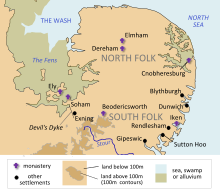Sigeberht of East Anglia
After his step-brother Eorpwald's assassination in about 627, Sigeberht returned to East Anglia and (perhaps in the aftermath of a military campaign) became king, ruling jointly with Ecgric, who may have been either a son of Rædwald's, or his nephew.Alliances were strengthened between the Christian kingdoms of Kent, Northumbria and East Anglia, with Sigeberht playing an important part in the establishment of the Christian faith in his kingdom: Saint Felix arrived in East Anglia to assist him in establishing his episcopal see at Dommoc, he started a school for teaching Latin and he granted the Irish monk Saint Fursey a monastery site at Cnobheresburg (possibly Burgh Castle).[17] Sigeberht established the bishop's seat of his kingdom for Felix at Dommoc,[18] claimed variously for Dunwich or Walton, Felixstowe (both coastal sites in Suffolk).[19] Sigeberht secured the future of the Church in East Anglia when he established a school in his kingdom so that boys could be taught reading and writing in Latin, on the model that he had witnessed in Gaul.[20] According to the Life of Gregory the Great, Paulinus of York, who from 633 to 644 was the Bishop of Rochester in northern Kent, had been connected with Rædwald's court during the exile of Edwin.[28] The site occupied a strong position on the upper reaches of the Lark valley, which drains north-west into the Great Fen through important early settlements at Icklingham, Culford, West Stow and others.[29] At an unknown date, which may have been in the early 640s,[30] East Anglia was attacked by a Mercian army and Ecgric was obliged to defend it with a much smaller force, though one that was not negligible.The East Angles appealed to Sigeberht to leave his monastery and lead them in battle, hoping that his presence and the memory of his former military exploits would encourage the army and make them less likely to flee.[32][33] The Church that Sigeberht had done so much to establish in East Anglia survived for two centuries, enduring 'evil times' (such as the period when the kingdom was under attack by the armies of Penda of Mercia).[35][36][37] Lives of the English Saints, written by John Henry Newman in 1843, is amongst the texts that gives Sigeberht's feast day as being observed on 29 October.

King of the East AnglesEcgricRicberhtWuffingasRædwaldAnglican CommunionCatholicismEastern OrthodoxyCanonizedPre-congregationCatholicEastern Orthodox Churches25 JanuaryOld EnglishEast AngliaAnglo-SaxonNorfolkSuffolkEcclesiastical History of the English PeopleRædwald of East Angliakingdom of EssexEorpwald'sNorthumbriaSaint Felixepiscopal seeDommocSaint FurseyBurgh CastleEorpwaldkingdom of East AngliaWilliam of MalmesburyEast Saxon royal houseAnglian collectionEdwin of NorthumbriaEadbaldDagobertClothar IIHereswithaHilda of WhitbyFelix of BurgundyBurgundyHonoriusArchbishop of CanterburyThomasBerhtgisl BonifaceDunwichWaltonFelixstowePaulinus of YorkRochesterCanterburySaint ColumbanusLuxeuilSaint AidanLindisfarneAthloneRoman fortGreat YarmouthIrish ChristianityBury St EdmundscurtilageLark valleyIcklinghamCulfordWest StowSaint AugustineMercianPenda of MerciaGreat Heathen ArmyJohn Henry Newmangive 16 JanuaryEcgric of East Angliapublic domainChisholm, HughEncyclopædia BritannicaWhitbyHenry of HuntingdonStenton, Sir FrankYorke, BarbaraAubrey De VereProsopography of Anglo-Saxon EnglandEnglish royaltyKing of East AngliaEcgric (alone)Monarchs of East AngliaTytilaÆthelhereÆthelwoldEaldwulfÆlfwaldBeonnaAlberhtÆthelred IÆthelberht IIEadwaldCœnwulfCeolwulfBeornwulfÆthelstanÆthelweardEdmund the MartyrOswaldÆthelred IIGuthrum IEohricGuthrum II